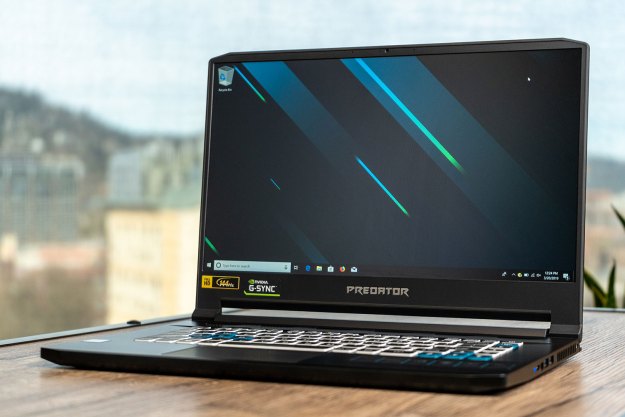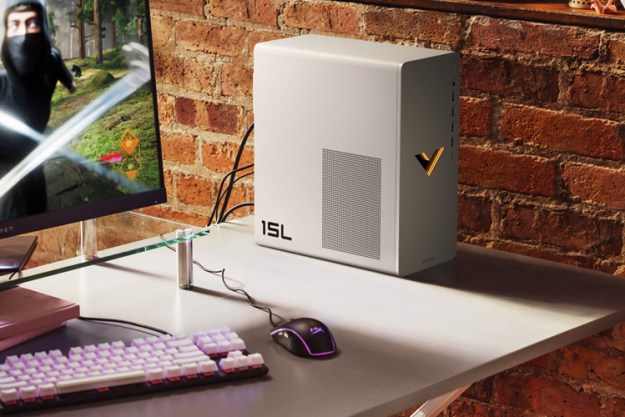
- Slim, light design
- Pleasant keyboard
- Strong game performance
- Good value
- Generic looks
- Short battery life
Gaming laptops have followed the Razer Blade on its march towards ever-thinner design. What once seemed rare has now become common. Purchasing a thick, bulky laptop now feels unusual. Even gamers must go out of their way to buy such a beast.
Few
That’s an incredible achievement, but it also begs the question – what was sacrificed? Is modern hardware truly this efficient, or did Acer slash battery capacity and throttle the GPU to cram everything in to the Triton 500’s small chassis? Let’s find out.
Hiding in plain sight
Some predators stalk their prey, moving silently out of sight. Acer’s Predator Triton 500 takes a different approach. It hides on your desk and counts on its non-descript style to help it pass unnoticed.
That’s not to say it’s ugly. No — that would attract attention. The Triton 500 is just generic. Its flat, deep blue exterior offers few flourishes. A repeating pattern of geometric shapes along the speakers, which repeat on the rear fan vents, are as close as the laptop comes to making a statement. I can easily imagine this laptop sold with an Asus, MSI, or Gigabyte badge instead.
While the Acer Predator Triton 500 lacks style, its design is functional and offers the modern conveniences gamers will expect. It’s thin and light, as mentioned already, and has a thin-bezel display design that keeps the overall footprint small. The webcam remains up top, where it should be, and the keyboard deck provides plenty of space.
It’s only a hair larger, and less than a half-pound heavier, than the Dell XPS 15.
Connectivity is also a high point. You might expect the slim profile to mean fewer options, but the Acer Predator Triton 500 squeezes in three USB-A 3.1 ports, A USB-C 3.0 /Thunderbolt 3 jack, mini-DisplayPort, HDMI, and separate headphone and audio jacks. There’s even a full-sized Ethernet port. That’s a great array of options that puts most of today’s
The subdued look and wealth of ports does make me wonder if Acer is trying to please gamers who also want a workstation. Razer’s Blade has popularized
A key component
This strangely professional vibe continues with the keyboard. Though LED-backlit, it lacks the features you might normally expect from a

If you can get over that, however, you’ll come to enjoy the simple and comfortable keyboard. The layout is spacious and keys activate with plenty of travel and bottom out with a feel that’s at once soft and defined. I instantly felt comfortable using it. The only quirks include small function keys (which didn’t bother me) and a small right-side Shift key (which did).
The touchpad follows the theme so far. It’s functional and enjoyable but doesn’t stand out from the crowd in either size or features. Competitors like the Razer Blade do offer a better touchpad experience overall, mostly due to a larger touchpad surface, but I found the Triton 500 perfectly responsive. The laptop even supports Windows Precision Touchpad drivers that make maximum use of multi-touch gestures.
An unsurprisingly solid display
The Acer Predator Triton 500 goes for a 1080p G-Sync display with a 144Hz refresh rate instead of a higher resolution panel with a lower refresh rate. Whether that’s the right call will depend on the games you play. First-person shooter fans will love the extra fluidity, but a Civilization player might’ve preferred the crisp look of a 1440p or even
Resolution is only part of the equation, however. Quality is at least as important. The Triton 500 didn’t blow us away. But, it looked good and did so while offering a matte screen that is easy to enjoy even in a brightly lit room.
Our test results showed the Predator Triton 500 is at least as good as its prime competition. The contrast ratio came in at 910:1, which is better than the Razer Blade 15 we reviewed, and just behind the Asus ROG Zephyrus S GX701. Color gamut and color accuracy are right in line with the competition, as well.
I did notice one strange result – a gamma reading of 2.5. This means the picture is a bit darker than it should be. This leads to noticeable shadow crush in some scenes. It might even be a problem for competitive gamers, because you may not be able to see an enemy in the shadows that would be visible on other

My personal impressions lined up with the test results. Acer’s Predator Triton 500 didn’t blow me away, but its visual quality is solid. It looks best in colorful, vibrant games like Fortnite, where its decent color accuracy and contrast help the graphics stand out.
Did you hear something?
An upward-facing speaker system is positioned above the Acer Predator Triton 500’s keyboard. It offers a direct, unobstructed path towards your ears. Sound quality is clear is crisp, but severely lacking in bass. Maximum volume is low, as well. External speakers or a good gaming headset will be your best bet.
The Core i7-8750H is predictably quick
Acer ships the Acer Predator Triton 500 with the usual Intel Core i7-8750H, a six-core, 12-thread chip with a maximum turbo boost frequency of 4.1GHz. Most
The Predator Triton 500 posts processor benchmark scores that, like the rest of the laptop, don’t stand out from the crowd. The Geekbench 4 multi-core score of 19,263 is below the Lenovo Legion Y740 or Asus ROG Zephyrus S, but better than the Razer Blade (2019).
Using Handbrake to test video transcoding doesn’t change the story. The Acer Predator Triton 500 needed 155 seconds to transcode a
The Acer Predator Triton 500 exceeded 60 frames per second in every game except for Assassin’s Creed Odyssey.
All this might sound a disappointing, but it’s worth noting the Triton 500 is a smaller laptop than the Legion Y740 (which is thicker) and the Asus ROG Zephyrus S (which as a 17-inch screen). The Razer Blade is the most direct comparison here, and the Acer does score a win against it.
We also tested the 512GB solid state drive with Crystal Disk Mark. It hit read speeds of 1,337 megabytes per second (MB/s) and write speeds of 1,058 MB/s. Most competitors are slightly faster because they use Samsung 970-series NVMe drives. The Acer, meanwhile, uses a Western Digital SN720 NVMe drive, and it can’t quite keep up. It’s fast, just not quite as quick as the competition.
(Almost) 60 FPS in every game
The base Acer Predator Triton 500 sells for $1,800 and comes with a Nvidia GeForce RTX 2060 Max-Q graphics chip, but our upgraded review unit came with an RTX 2080 Max-Q. That bumps the price up to $2,500, but that’s standard for a laptop with Nvidia’s top-tier graphics chip. Let’s see how it performs in 3DMark.
The Time Spy benchmark spat out a score of 6,930 on the Acer Predator Triton 500. That’s quite good, easily defeating other 15-inch
Legion Y740 15-inch. However, the Asus ROG Zephyrus S GX701 sails by the Acer Predator Triton 500, achieving a score of 7,944. That’s a bit troubling because it, too, has the RTX 2080 Max-Q hardware. The Acer will have to do better in real-world gaming if it hopes to hold out. It’s time to dive into the games.

The Acer Predator Triton 500’s Nvidia GeForce RTX 2080 Max-Q delivers strong, though sometimes muddled, results in our benchmarks. Its prime competition in our tests is the Asus Zephyrus S GX701, a 17-inch system with the same RTX 2080 Max-Q and a higher $3,300 price tag. The Triton 500 trades blow with that system, edging a small win in games like Battlefield V and Civilization VI but losing in Fortnite and fighting to a virtual tie in Assassin’s Creed: Odyssey. That’s a positive result for the Acer, which retails for an incredible $700 less than the Asus Zephyrus S GX701.
That said, the results are more confusing than you might think. In Fortnite, for example, the Acer Predator Triton 500 performed about the same as
Here’s the key result; the Acer Predator Triton 500 exceeded an average of 60 frames per second in every game except for Assassin’s Creed: Odyssey at ultra-high detail, which came up a hair short at 57 frames per second. This unfortunately means you won’t always get the most out of the 144Hz G-Sync panel, but you will see smooth gameplay even in the most demanding games sold today. That’s impressive for a thin laptop that’s also (relatively) affordable.
We also tested the laptop with an external

Surprisingly, heat never felt like a major issue. You won’t want to game with this laptop on your lap, as is true of any high-end
G-Sync sinks the battery life
The Acer Predator Triton 500’s inclusion of G-Sync decreases battery life in normal use because G-Sync is not compatible with Optimus switchable graphics. That means the Nvidia RTX 2080 Max-Q chip is always engaged and consuming power. Like some of its peers, such as the Asus Zephyrus, a software toggle can be used to turn off G-Sync and enable Optimus. That requires a system restart, however, so it’s not convenient.
Battery life in stock settings (with Optimus off) is quite bad. Even the video loop doesn’t break four hours. Most modern
With that said, the battery life is better than the worst
Yes, the Optimus toggle exists, but it’s a real hassle to use. It’d be nice to see Acer offer an alternative display option that drops G-Sync but increases resolution. Even a
Our Take
The Acer Predator Triton 500 is a powerful yet thin
Is there a better alternative?
Many alternatives are available, but most aren’t as affordable. Only MSI ships anything in the same league. Most competitors, like the 15-inch version of the Asus Zephyrus or the Razer Blade, are much more expensive. Other possible alternatives, like the 15-inch Lenovo Legion Y740, don’t offer the RTX 2080 Max-Q.
Razer’s Blade remains our favorite pick among
How long will it last?
The high-end hardware in the Acer Predator Triton 500 will keep it running for years. Even the RTX 2080 Max-Q will likely remain relevant for three to five years. A two-year warranty comes standard, which is better than the usual one-year warranty found on most
Should you buy it?
Yes. The Acer Predator Triton 500 may be hobbled by its short battery, but its competition shares the same injury. Gamers looking for serious performance at minimum price need to put the Triton 500 on their short list.
Editors' Recommendations
- 9 best laptops of 2024: tested and reviewed
- The 10 best monitors for 2024: tested and reviewed
- 9 best processors for PC gaming: tested and reviewed
- 10 best gaming monitors of 2024: tested and reviewed
- Best color laser printers for 2024: tested and reviewed







